Ruth Weisberg Unfurled (2007 catalogue of exhibition at Skirball Cultural Center, Los Angeles, CA)
There is a special class of Jewish artists who toil in the rich fields of Tanach and Jewish practice for years and years, quietly establishing a foundation of visual and intellectual markers for generation of artists to come. Ruth Weisberg is clearly one of these founders. Her seminal work articulates an approach to the Jewish narrative deeply informed by a Jewish feminism. In 2007 the Skirball Cultural Center in Los Angeles hosted a large retrospective surveying 30 years of Weisberg’s works. Along with 30 other artworks, the dramatic centerpiece of the show was The Scroll, a 94 foot long mixed media drawing that is an exploration of how Jewish history can be visually reflected in a personal narrative. Many of the other significant works evidence Weisberg’s concerns with Jewish memory and experiences.
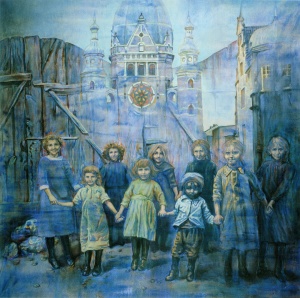
The Past: The Great Synagogue of Danzig (1984) sets the tone for these musings by depicting nine children holding hands in front of the an apparition of the ill fated house of worship. First built in 1887 this synagogue soon became an important center for the German Reform movement. It fell victim to the waves of anti-Semitism in 1938 and was finally demolished by the Nazis in 1939. The children stand as a stark paradox to the historic façade, sweetly smiling as innocent survivors of the Holocaust. Their clothes echo the troubled past in ghettoized Poland and yet their smiles radiate a deeply hopeful future.
Weisberg believes that “the Bible is most potent when we find our own stories in its narratives,” and ponders its consequences in The Story of Ruth and Naomi (1988). The image appears disarmingly simple. Naomi on the left has paused as Ruth approaches and implores her “for where you go, I will go, where you lodge, I will lodge, your people are my people and your God is my God…” Complexity arises as we notice that “Naomi” is partially transparent, the landscape horizon clearly visible through her upper torso. Perhaps more significantly, the two women look almost identical, as if they were projections of each other. It is this insight that leads us to remember that both have been tragically widowed; both have lost everything and face uncertain future prospects. In reality they only have each other as a veritable reflection of need and vulnerability. The mystery and tenderness of this work opens up the Ruth narrative as no other.
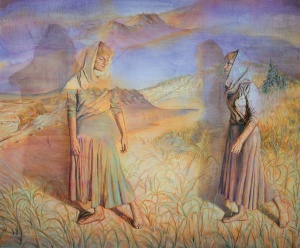
Teaching painting, drawing and printmaking at the University of Southern California since 1970, Weisberg quickly became a leader in the growing Jewish feminist movement. Those times of questioning and exploration combined with a growing commitment to Jewish learning and observance to drive much of her artwork into Jewish themes with a feminist cast. Additionally her study at the Academia di Belle Arti in Perugia, Italy and a visiting artist residency at the American Academy in Rome cemented a lifelong love of the Italian Renaissance and classical techniques. In Genesis: A Woman’s Voice, Weisberg’s series of figures underwater are a potent combination of Jewish ritual, i.e. the Mikveh and a classical approach to the female form. This series of mixed media on paper, oil on canvas and monotypes are a unique exploration of the deeply peaceful and meditative experience that Mikveh evokes along with a startling modern abstract painterly sensibility in depicting the manifold underwater reflections that dapple the walls, floor and floating figures. These works are transformative of both the Mikveh experience and modern painterly figuration.
Regardless of the importance of the aforementioned works, the mere scale and ambition of the centerpiece of this exhibition, The Scroll, defies comparison. The eminent Jewish Art historian Matthew Baigell considers it “one of the most important works ever created in the entire history of Jewish American Art.” Additionally he observes that this massive drawing, 94 feet long and 44” tall (with one section 88” tall), is the “first mural cycle–or extended narrative–that addresses Jewish subject matter from a Jewish feminist point of view.”
The Scroll was installed in the round so that the viewer was literally engulfed by the images to become a mikveh of Jewish memory. Weisberg utilizes three non-linear techniques to weave her narrative: Synchronic Time; i.e. different layers historical times; Continuous Narrative; i.e. conflating scenes to show the same person at different times in one story; and Visual Midrash in which rabbinic metaphors are visualized. All of these techniques are utilized to present a visual narrative that unfolds in three distinct sections: Creation, Revelation and Redemption.
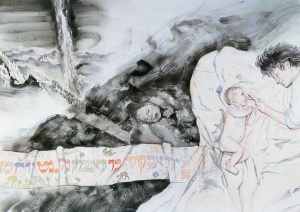
Creation begins with a rush of the Jewish masses until a lone individual emerges. Next we witness the symbolic birth of a single person. An angelic figure lies beside the child, gently touching its upper lip; calming its passage to life, erasing its Torah wisdom and inaugurating its journey into a Jewish life of learning (see Ginzberg, Legends of the Jews, pg 58). Immediately the child is plunged into birth and the wilderness of Sinai, receiving the Torah and finally the covenant of circumcision. This whole scene plays out above a wimple, symbolic of the themes that will dominate throughout the child’s life. This full set of images, especially the angel and the infant, is surely the most moving and tender evocations of the mystery of creating a human life I have seen in contemporary Jewish Art.
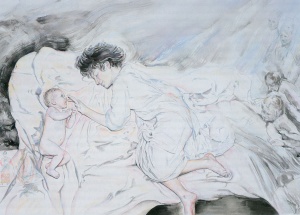
The Scroll then delineates the passage from childhood to adulthood; circles of children dancing in Weisberg’s own childhood, Polish Jewish children dance in innocence and finally youth survivors in displaced persons camps preparing to make aliyah. The entire section frames a depiction of Weisberg’s daughter’s Bat Mitzvah.
Next the Revelation section moves deeply into the personal narrative of a contemporary wedding even while referencing Miriam and the Israelite women dancing at the Red Sea. A man, woman and rabbi are seen under the chuppah about to step into their life together as a contemporary Simhat Torah is celebrated to much dancing again and joy.
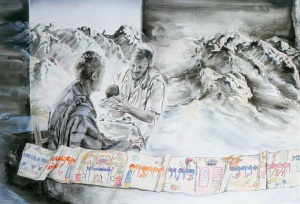
The final section of Redemption concentrates on Israeli landscapes as concentration camp uniforms blend into scenes of Jerusalem. Finally a multitude of Jews from the past reappear as if to affirm yet again our dependence upon tradition even as it is engaged and questioned.
Weisberg’s The Scroll is dominated by women and children, many of whom are similar in age and dress. While surely a forthright Jewish feminist visual manifesto, i.e. the dominance of women in religious roles and garb; the overall tone and specific details is neither strident nor hostile to males. By and large male roles are just ignored for a uniquely feminine perspective.
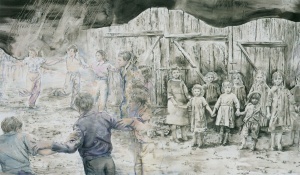
This seminal artwork establishes a profoundly optimistic vision of Jewish history and future prospects that paved the way for much of Weisberg’s future work, even those works that do not have Jewish content. Many recent works explore the relationship between Renaissance masterworks and the 21st century contemporary individual. That said, what is perhaps the most laudable aspect of the works in the 2007 exhibition is its determination to explore and celebrate Jewish subjects in a contemporary setting, even while preserving much of its traditional sources and legitimacy. This example of ambition and commitment is something all contemporary creators of Jewish Art can well take to heart.
N.B. I am deeply indebted to Barbara Gilbert, Matthew Baigell and Donald Kuspit, the essay contributors to the 2007 catalogue, Ruth Weisberg Unfurled, for background information and insights into this exhibition.